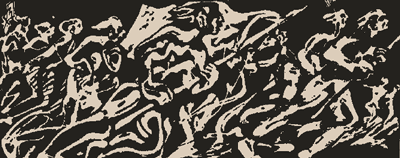05
Somnath
Hore was among the generation of great Bengali artists who saw
their art utterly revolutionised by the events of his time. Artists
like Chittaprasad, Debabrata Mukhopadhyay, Zainul Abedin and a whole
generation of aspiring painters, poets, theatre activists, writers,
and musicians dedicated their entire time and energy in redefining
their role as artists in society.

Somnath Hore, A Tebhaga Procession,
1946
The memories of past nationalist upsurges, the experience of the
Great Bengal Famine (1943), and the historic peasant struggle known
as Tebhaga (1946) decisively shaped the life and art of many an
artist and writer in 1940s and 1950s. The work they produced remains
unmatched in terms of the energy, intensity and the forceful use
of creative imagination in the wider interests of fellow human beings.

Chittaprasad, Tebhaga
In December 1946, a young artist in Calcutta, Somnath Hore decided
to travel to Rangpur in north Bengal to document the Tebhaga Movement
as part of his artistic duty. His sketches
and wood engravings of that time now are part of the great artistic
heritage of Bengal and an important statement in the history of
revolutionary art.

Debabrata
Mukhopadhyay, Tebhaga
Forty
six years after these sketches were originally made, the artist
had an occasion to describe them thus (in
the 1989 preface to his book): "These
sketches were made when I was in my second year as a student at
the Government Art College in Calcutta. One should not expect any
artistic skill from them. Still, even today, my attachment to these
drawings remain strong."
Somnath Hore, TEBHAGA: An Artist's Diary and Sketchbook
Translated from Bengali by Somnath Zutshi, with an introduction
by Samik Bandyopadhyay
( Seagull Books,
26 Circus Avenue, Calcutta 700 017; xiii,
61 p., pb, Rs70.00; ISBN
81 704B 079 4)
Tebhaga
Sketches and Wood Engravings
|